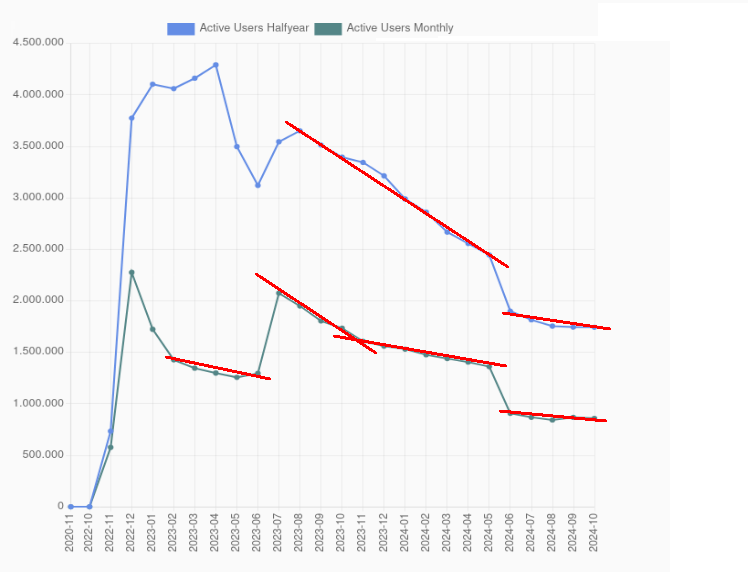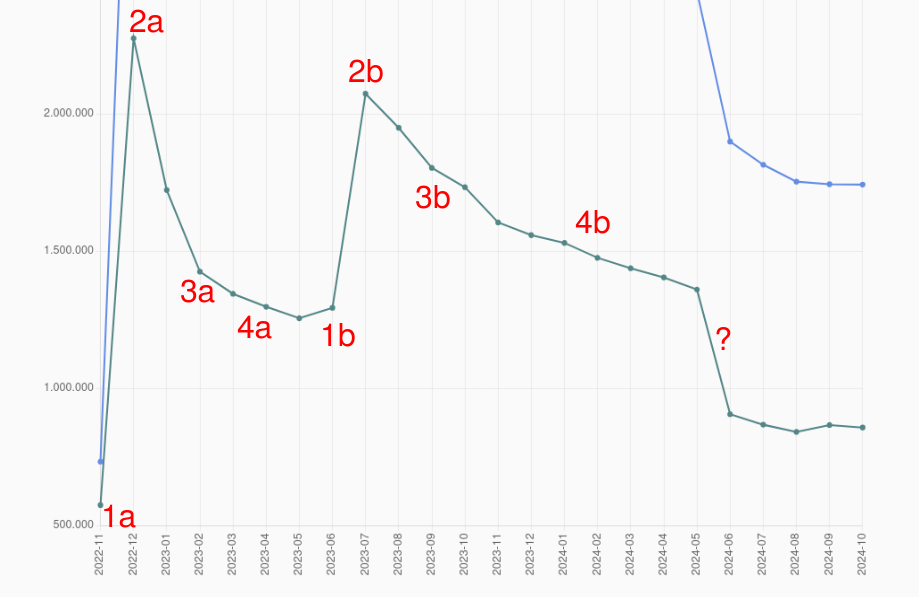I don’t like the clickbait title at all – Mastodon’s clearly going to survive, at least for the forseeable future, and it wouldn’t surprise me if it outlives Xitter.
Still, Mastodon is struggling; most of the people who checkd it out in the November 2022 surge (or the smaller June 2023 surge) didn’t stick around, and numbers have been steadily declining for the last year. The author makes some good points, and some of the comments are excellent.
Let’s see:
Network effect hits Mastodon specially hard as it competes not just with Twitter, but also Threads and Bluesky. In those situations, a smaller userbase means that people will outright ignore you as an option.
The way that federation was implemented; as linearchaos mentioned in another thread, if you settle in a smaller instance (the “right” thing to do), you won’t get “good collections of off node traffic”. So it creates a situation where, if you know how federation works you’ll avoid big instances, and worsen your own experience; and if you don’t, well, Mastodon’s big selling point goes down the drain.
Federation itself introduces a complexity cost. That’s unavoidable and the benefits of federation outweigh the cost by far; however, the cost is concrete while the bigger benefit is far more abstract.
Branding issues. Other users already mentioned it, but you don’t sell a novel tech named after an extinct animal.
And this is just conjecture from my part, but I think that microblogging is becoming less popular than it used to be; people who like short content would rather go watch a TikTok video, and people who want well-thought content already would rather read a “proper” blog instead.
On a lighter side: the very fact that we’re using the ActivityPub now helps Mastodon, even if we’re in different platforms (like Lemmy, MBin, PieFed, SubLinks). Due to how federation works, you’re bound to see someone in Mastodon sharing content with those forums and vice versa; it could be a bit less clunky but it’s still more content for both sides.
On the text: I think that the author reached the right conclusion through the wrong reasoning. The activity peaks don’t matter that much, when there’s a huge influx of users you’re bound to see some leaving five minutes later. The reason why Mastodon is struggling is this:

See those slopes down? They show that the stable userbase is shrinking. Even users engaged enough with the platform are slowly leaving, but newbies who could fill their place aren’t popping up.
you don’t sell a novel tech named after an extinct animal
They didn’t, Mastodon is named after the metal band (which is named after the extinct animal) 🙂
Either way, back in 2008 I bet people were making fun of Twitter for being named after bird sounds, so.
I wasn’t aware of the connection with the band - thanks for the info! Still, people are bound to associate “mastodon” first and foremost with the critter.
Either way, back in 2008 I bet people were making fun of Twitter for being named after bird sounds, so.
I don’t remember but you’re likely correct. There’s a difference though - Twitter didn’t need to capitalise on every single tiny advantage, Mastodon does it, and while the role of branding might be small it still gives you (or your competitors) some edge.
They created a name clash with the band on purpose? Because they’re fans? That’s rich.
“He”, not “they” — if I understand correctly this was way back when Eugene Rochko was the sole developer — but yes. Same as Lemmy being named after Lemmy Kilmister, and Debian major versions after Toy story characters.
I don’t see what’s “rich” about that, it’s just developers having personal tastes outside of coding.
Exactly copying a name is a bit strange to me. I have always been under impression that whoever named the social network has been unaware of the band.
Lemmy and Debian are not the same.
I disagree with your and the author’s conclusions.
I have made my own long comment about it in thread, so here I am going to focus on your chart.
First, I will accept the data of the chart at face value, it seems resonably accurate and I don’t have any other data to work off of.
My point is that you are interpreting it wrong.
To me the declining slopes after the sruges are not relevant to any long term conclusions, they follow a highly predictable curve and doesn’t mean much.
If you look at the end of the graphs you can even see it growing slightly, that is obviously not evidence of anything yet, but to me it is an indication of either a start of another surge, or stability.
I believe you are too quick at spreading doom for Mastodon, give it half a year and look at the stats then, we won’t see a meteoric rise of active users any time soon, just accept it and work with more realistic expectations.
First, I will accept the data of the chart at face value, it seems resonably accurate and I don’t have any other data to work off of.
If you do find another source of data, please post it. Relying on a single source (like the Fediverse Observer) is problematic, I know.
To me the declining slopes after the sruges are not relevant to any long term conclusions, they follow a highly predictable curve and doesn’t mean much.
You’re conflating the sharp drops after the surges with the declining slopes.
The sharp drops (like MAU from 12/2022 to 02/2023) go as you said, they don’t mean much. However, the declining slopes are relevant - they span across multiple months (up to ten), and show that Mastodon userbase has a consistent tendency to shrink.
If you look at the end of the graphs you can even see it growing slightly, that is obviously not evidence of anything yet, but to me it is an indication of either a start of another surge, or stability.
We’ll only know if it’s an indication of a surge (sudden influx of new users), or growth (slow influx), or stability in the future. For now it’s an isolated data point.
I believe you are too quick at spreading doom for Mastodon
I’m saying that Mastodon is struggling. I did not say that Mastodon is doomed.
The difference is important here because a struggling network can be still saved, while a doomed one can’t.
The slopes you meassure are still tied to the preceeding surges, so I can’t treat them as any indication of success/failure.
To me it kinda looks like we are in the trough of disillusionment, which is a normal period of any new tech/system.
With improvements to the network we soon hit the slope of enlightenment.
Context for other users - the user above is likely referring to the Gartner cycle:

As anyone here can see, it looks nothing like that pattern that I’ve highlighted.
If the success condition for Mastodon is “to become a long-term viable and attractive alternative to corporate-owned microblogging”, then improvements of the platform are necessary.
To be clear on my opinion in this matter: I want to see Mastodon to succeed, I want to see X and Threads closing down, and IDGAF about Bluesky. However I’m not too eager to engage in wishful belief and pretend that everything is fine - because acknowledging the problem is always the first step to solve it.
You are absolutely right that I am refering to the Gartner cycle.
It doesn’t fit exactly, but the general pattern fit very well with the first half.
The Mastodon graph just happens to have two hype sections.
A model that explains well half of the data is as useful as a coin toss. But let’s roll with it, and pretend that we got two superimposed Gartner cycles here.
The trough would be reached after a sharp drop after the peak, and based on the first peak it would be ~2 months long. That would explain only the period between 2023-07 and 2023-09; the rest of what I’ve pointed out in red is clearly something else, the nearest of what they look like would be a sick version of the “slope of enlightenment” - going down instead of up.

Yeah, the model doesn’t work.
A better way to approach this is to consider three things:
- The main selling point is federation.
- Federation is only perceived as useful for your typical user when a competitor abuses power.
- Mastodon has the drawbacks already mentioned all the time, not just when the competitors fuck it up.
Once you notice those things, it gets really easy to explain what’s happening:
- the peaks are caused by Musk’s acquisition of Reddit and Threads being released (as it brought a lot of discussion about federation up)
- overexcitable people take 1~2 months to realise that Mastodon is not just “Twitter minus Musk”.
- the drawbacks are always there, so Mastodon slowly bleeds users, while only gathering new ones when Musk/Zuckenberg/etc. do something shitty.
By analysing the data this way, not just we’re describing it better, but we can also see where Mastodon needs to improve:
- It needs killer features that are clearly visible for everyone, regardless of federation or “Musk pissed off users”
- It needs to be promoted better. Even among non-Twitter/Bluesky/Threads users.
- Federation itself needs to be promoted better, with simple words, showing why leaving Twitter for yet another walled garden won’t solve shite in the long run.
What I’m saying also partially applies to the “Fediverse link aggregators”, like Lemmy. Lemmy does show some tendency to bleed users, but in smaller degree than Mastodon; but it’s in a better position because there’s only one big competitor, and it keeps fucking it up over and over.
Half the users of the initial peek are still active?
Doesn’t sound too bad if there would be events that bring new users from time to time.



